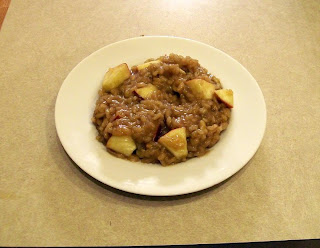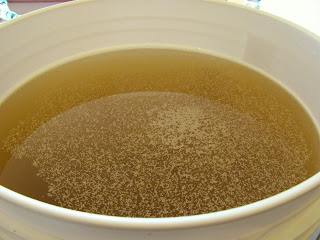
As I've mentioned previously, I enjoy making, and of course drinking, wine at home. I’m sure many of you are having images of crates full of grapes, maybe stomping them to get the juice, etc. The wonders of modern technology make things so much easier. To prove this, will introduce you to the wine kit.
A wine kit gives you all the ingredients you need to create 6 gallons (30 bottles), of nice drinkable wine at home. There are varying levels of quality in the kits, but if you follow the included instructions, pretty much anyone can make a decent wine at home, often in less than a month. With some relatively simple tweaks, and a bit more time, you can make it even better, at little or no additional cost.
The ingredients you will find in any particular wine kit will vary by manufacturer and product line, but the basics will generally include, but not be limited to, the following:
Juice concentrate: This of course is the actual grape juice that becomes the wine. This package (generally a double walled plastic bag with large plastic cap), will contain anywhere from 5 to 23 liters of grape juice. This juice will already have been balanced as to acidity, tannin, sugar content, etc, to make a quality batch of wine. It will also tend to conform to levels in previous batches of that wine kit made by the manufacturer in the past. This lets you make a consistent product, and if you find a wine you like one year, it will (hopefully), taste the same if you buy another kit of the same wine the next year.
Yeast: This of course is the workhorse of the whole process. Yeast is a living organism that consumes sugar, and releases the ethanol that changes that grape juice into tasty wine. This process, which is known as fermentation, also releases carbon dioxide, which is helpful in beers, but can be annoying in winemaking.
Potassium Metabisulfite: One of the primary enemies of wine is oxidation. An oxidized wine will taste rather flat or stale. This is why wine is sealed under a cork or screw cap when it is in the bottle. While the wine is being made though, sulfites protect the wine from oxidation. Potassium metabisulfite also works with Potassium sorbate, which is next up on the list.
Potassium sorbate: When wine is fermenting, the yeast releases carbon dioxide. If this is still happening after you cork it, you will eventually end up with a wine explosion. This is because the mounting carbon dioxide will raise the pressure in the bottle until the cork bursts out. Not exactly something you want to happen, especially with a red wine. Potassium sorbate, along with potassium metabisulfite, helps combat this problem. It doesn’t stop fermentation, per se, as so many people think. What it does do though is keep the yeast from reproducing. So once the current yeast in your wine dies off, the fermentation will stop.
Clearing Agents: As the name would indicate, clearing agents help clear the wine. The fermentation process, and even the grape juice itself, contains various impurities, contents, etc, that keep you from having that wonderful clear glass of wine that you are used to. While they may not affect the actual taste of the wine, they aren’t attractive, and can put you off a glass of wine.
Bentonite: The first clearing agent you will generally see and use is bentonite. This is generally added at the start of fermentation, before anything else. This is because the yeast will cling to the bentonite and drop out of suspension faster. The alcohol will still be formed, but the yeast won’t hang out floating in the wine and leaving it hazy. When you open the package, your first thought will probably be that it looks like kitty litter. This idea isn’t far off. Like many kitty litters, bentonite is a type of clay. Don’t worry though; your wine won’t taste like a litter box.
Kieselsol and Chitosan: Chitosan is a shellfish derivative, so be aware of this if you have any type of allergy. Impurities that make your wine cloudy will have either a positive or negative charge. These clearing agents each bond with impurities of a specific charge, and pull it out of suspension. You do want to make sure that you pay attention to the instructions as to which order and how to add them. If you get them reversed, the two clearing agents will just bond to each other, rather than the impurities in the wine, and then you’ll still have a cloudy wine.
Optional items: These are some other things you might find in your wine kit
Grape pack or raisins: More expensive red wine kits will often include these. Grape packs or raisins help add more body and flavor to the wine. This of course goes along with fact that most red wines are fermented on the grape skins, at least for a short time.
Oak: Many wine kits will have oak with them. This may be in the form of sawdust (yes, this looks exactly like you’d expect), chips, cubes, or spirals. These helps impart an oaky flavor to the wine, and can also absorb some of the sharper flavors. Not all kits will have them, or can even benefit from them, so don’t add oak to a kit that doesn’t have it unless you’re sure it will be an improvement.
Elderberries or elderflowers: These add to the flavor, and help round out a wine’s flavor profile
Starting next week, I will chronicle making a batch of wine from start to finish. If you'd like some more information before that though, check out the following sites:
Tim's Wine Blog Tim is the Technical Manager for Winexpert, one of the largest wine kit manufacturers in the world, and the maker of the kits I first started out with. A very interesting character and one of the nicest and most knowledgeable people on the Internet when it comes to wine kits.
Winepress.us Wine Forums These forums are a great resource for research and asking questions. A great group, they're always happy to answer questions and help someone out with an issue.









